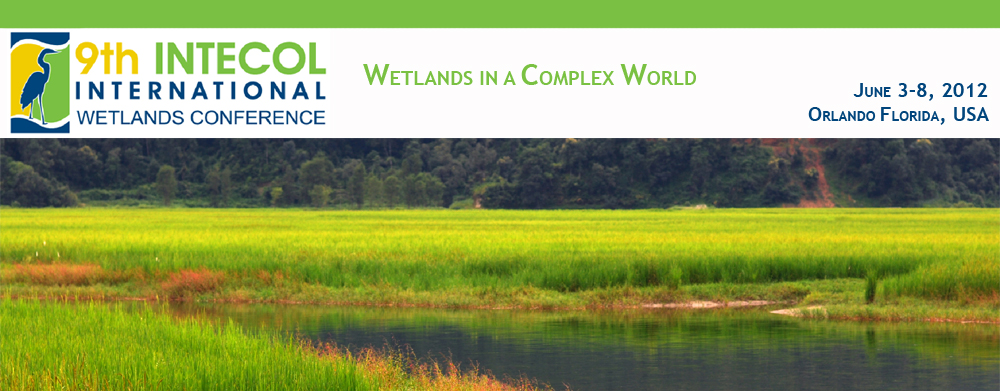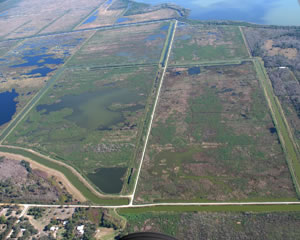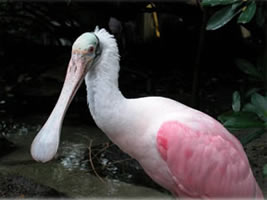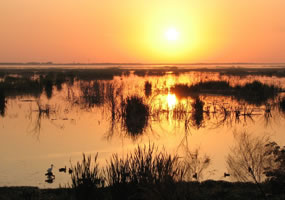

Please note the number of participants individual field trips are limited to is published at the top of each flyer. Field trip seating is very limited therefore participation is restricted to meeting attendees only. Sorry, no guests.
A PDF of ALL Field Trip flyers will be available soon.
Cape Canaveral Wetlands (Limited to 25 people)
Detailed Tour Information (Printable PDF) coming soon. |
||||
Disney Wilderness Preserve (Limited to 20 people)
Conservancy staff has restored the preserve so that approximately 4,000 acres of wetlands once again exist within its boundaries. As “nature’s sponge”, wetlands are the life-blood of peninsular Florida. Rain filters through the preserve’s uplands into lower-lying wetlands that capture water, filter nutrients, replenish Florida’s aquifer and provide essential habitat for plants and wildlife. Detailed Tour Information (Printable PDF) coming soon. |
||||
Florida Springs Tour – Juniper Springs and Silver Glen Springs (Limited to 30 people) Tour participants will walk to the springs and hike through a network of trails within the recreation area of each spring. Juniper Springs is a second-magnitude spring with an oval-shaped pool that measures about 120 feet from north to south and 90 feet from east to west. Several limestone vents and sand boils are present on the pool bottom, with sand and aquatic grasses in other areas of the pool. The clear, bluish water has a low dissolved solids concentration compared with most Florida springs. A limestone and concrete wall with steps and other access points surrounds the pool. An old millhouse and spillway are on the east side of the pool. Numerous sand boils are located down the run from the main pool, with the largest by the bridge over the run. The springs are the headwaters of Juniper Creek, which meanders toward the northeast through the Juniper Prairie Wilderness for about 10 miles to Lake George.
Silver Glen Springs is a first-magnitude spring with a large, semicircular pool that measures 200 feet from north to south and 175 feet from east to west. Most of the strong flow emerges from two cavern openings in the rock at the bottom of the pool, with large boils at the water's surface over the vents. The vertical cave opening called the Natural Well in the southwestern edge of the pool is about 12 to 15 feet in diameter and 40 feet deep. The vent in the east part of the pool is a conical depression about 18 feet deep. Most of the spring pool has sand and limestone on the pool bottom, with areas of aquatic grasses. Large fresh and saltwater fish are common in the pool and around the vents. Additional flow is from sand boils in the bottom of the spring run downstream from the head of the springs. Water from the springs flows eastward down a run about 200 feet wide for 0.75 mile to Lake George.
Detailed Tour Information (Printable PDF) coming soon. |
||||
History and Habitat Tour – Fort Christmas Historical Park and the Orlando Easterly Wetlands (Limited to 25 people) Fort Christmas Park has a full size replica Fort. Seven restored historical homes preserve the 'Cracker' architecture of East Orange County. The houses are interpreted to show pioneer life from the 1870s through the 1930s. Key themes are homesteading, cattle, citrus, hunting, fishing and trapping. Many interpretive displays are available.
Detailed Tour Information (Printable PDF) coming soon. |
||||
Orlando Treatment Wetlands – Orange Co. Eastern Water Reclamation Facility, Greenwood Urban Wetlands and Orlando Easterly Wetlands (Limited to 35 people) This tour will highlight two constructed wetlands in Central Florida. The Greenwood Urban Wetland receives and treats urban stormwater runoff from downtown Orlando, and the Orlando Wetlands Park receives tertiary treated wastewater from the Iron Bridge Wastewater Reclamation Facility before discharging to the St. Johns River. Both systems are excellent examples of integrated treatment wetland design and have been operational for almost two decades and provide insight into long-term management and performance of these systems. Additional information can be found for these three wetlands at: Detailed Tour Information (Printable PDF) coming soon. |
||||
SJRWMD Lake Apopka North Shore Restoration (Limited to 25 people) Tour will visit a site with ongoing restoration of 80 km2 of former agricultural lands to wetlands, including a 275-ha treatment wetland for nutrient removal from lake water (Lake Apopka Marsh Flow-Way). Topics covered include restoration of hydrologic conditions; nutrient control on former agricultural lands; persistence, bioaccumulation, and remediation of organochlorine pesticides in organic soils; and nutrient removal in a treatment wetland at high hydraulic loading and low inflow concentrations. Lake Apopka, northwest of Orlando, has been a focus of restoration efforts by the SJRWMD (St. Johns River Water Management District) since 1985. The tour will visit portions of 80-km2 former farmlands on the north shore of Lake Apopka in various stages of wetland restoration. You will see presentations on the overall restoration program for 125-km2 Lake Apopka and its watershed, on contaminant studies and soil remediation completed on the former farms prior to reflooding, and on a 275-ha treatment wetland for nutrient removal. Prior to the 1940s, Lake Apopka had clear water and abundant gamefish. Agricultural development of the floodplain wetland resulted in increased phosphorus loading to the lake that caused chronic algal blooms starting in 1947. The once abundant submersed macrophytes were eliminated by shading, and sportfish populations declined. Key to restoration of the lake is the reduction in nutrient loading through purchase of the farms and restoration of wetlands. Restoration of hydrologic conditions is complicated by the fact that decades of agriculture resulted in up to 2 m subsidence of the organic “muck” soils. The soils contain organochlorine pesticide residues and have a high phosphorus content. You will see abundant birds and wildlife. Participants are encouraged to bring binoculars and cameras and wear close-toed shoes. Bring rain jackets and sun protection as needed.    Detailed Tour Information (Printable PDF) coming soon. |
||||
Turkey Creek Wetlands Reserve Program Restoration Site (Limited to 30 people)
Florida’s wetlands provide habitat for fish and wildlife, including threatened and endangered species; improve water quality by filtering sediments and chemicals; reduce flooding; recharge groundwater; protect biological diversity; and provide opportunities for educational, scientific, and limited recreational activities. Since 1992 the U.S. Department of Agriculture’s Wetlands Reserve Program (WRP), administered by the Natural Resources Conservation Service (NRCS), has helped landowners voluntarily restore, protect and enhance wetlands. The cumulative benefits of the wetlands restored through WRP reach well beyond their boundaries to improve watershed health, the vitality of agricultural lands, and aesthetics and economies of local communities. WRP is a voluntary program that provides technical and financial assistance to private landowners and Tribes to restore, protect, and enhance wetlands in exchange for retiring eligible land from agriculture. Detailed Tour Information (Printable PDF) coming soon. |
||||
Upper St. Johns River Basin – Bull Creek & Triple N Ranch
(Limited to 30 people) Participants will experience the “real” Florida and will be able to see a wide variety of habitats. These vast wildlife management areas (Bull Creek = 23,470 ac; Triple N = 15,391 ac) will provide the opportunity to see many of Florida’s inland habitats ranging from sandy, scrubby areas to wet, peaty swamps and marshes. In Bull Creek WMA, trip leaders will present the hydrologic management challenges of managing an area of this size and then allow participants to foray into the swamp (wear shoes that can get wet!). Then we will head for higher ground and hear about the fire management and
invasive plant management techniques that are used to manage this diverse resource. Trip participants will get to visit some of the finest examples of several Florida habitats including Scrub, Palmetto prairies, Hardwood Hammocks, Pine Flatwoods, Marshes, and Hardwood Swamps. All along the tour, our Guides will point out rare and interesting plant species that occur in those areas (including hooded pitcher plant, bromeliads, butterfly orchids, sundews). Afterwards, we will head to the Triple N Ranch WMA to see Red-cockaded Woodpecker habitat (bring your binoculars!) and our FFWCC Guides will instruct participants on the dynamics of managing a federally listed species. Wildlife abounds in these areas with such species as sandhill crane, bobcat, deer, turkey and a plethora of other birds, amphibians, reptiles, and insects! Detailed Tour Information (Printable PDF) coming soon. |
||||
Wekiwa Springs and River Tour (Limited to 20 people)
Detailed Tour Information (Printable PDF) coming soon. |
| In Partnership |

|
| UF/IFAS Office of Conferences and Institutes This site is designed and maintained by the UF/IFAS/OCI Webmaster. |
INTECOL Wetlands Announcement (PDF)
Visa Information
Click here for Important Information for Foreign Travelers to the United States of America.
Social Media
Be part of the conversation
Ecology Blogs
Ecology at the Heart of the 21st Century -- University College London
EcoBloggers -- International Network of Next-Generation Ecologists